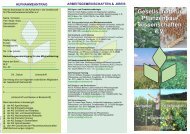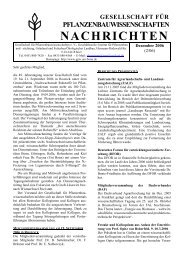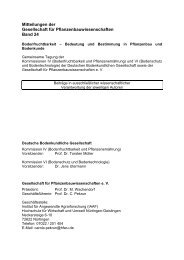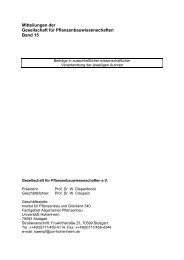Mitteilungen der Gesellschaft für Pflanzenbauwissenschaften Band 23
Mitteilungen der Gesellschaft für Pflanzenbauwissenschaften Band 23
Mitteilungen der Gesellschaft für Pflanzenbauwissenschaften Band 23
Erfolgreiche ePaper selbst erstellen
Machen Sie aus Ihren PDF Publikationen ein blätterbares Flipbook mit unserer einzigartigen Google optimierten e-Paper Software.
Mitt. Ges. Pflanzenbauwiss. <strong>23</strong>: 245 (2011)<br />
Spatial and temporal expression of a citrate transporter gene and<br />
aluminium-induced citrate exudation in common bean<br />
Dejene Eticha and Walter J. Horst<br />
Institute of Plant Nutrition, Leibniz Universität Hannover. E-Mail: eticha@pflern.uni-hannover.de<br />
Introduction<br />
Aluminium (Al) toxicity is one of the major limiting factors for plant growth in acid soils<br />
especially in the tropics where common bean (Phaseolus vulgaris) is produced. Al<br />
resistance in common bean is conferred by citrate exudation which detoxifies Al in<br />
the root apoplast. Citrate exudation starts after a consi<strong>der</strong>able lag period subsequent<br />
to Al treatment indicating that the activation of resistance mechanism involves Alinduced<br />
gene expression. We identified a putative citrate transporter gene PvMATE<br />
(P. vulgaris Multidrug and Toxin Extrusion) the expression of which is highly<br />
enhanced by Al treatment (Eticha et al., 2010). Here, the spatial and temporal<br />
expression of PvMATE in relation to citrate exudation is presented.<br />
Materials and Methods<br />
Two contrasting bean genotypes, Quimbaya (Al-resistant) and VAX 1 (Al-sensitive)<br />
were used to study gene expression as well as citrate exudation of the different<br />
apical root zones (0-3 mm, 3-6mm, and 6-10 mm).<br />
Result and Discussion<br />
PvMATE gene is more strongly expressed at the root tip compared to the elongation<br />
zone of Al-treated plants in agreement with higher citrate exudation at the root tip.<br />
Citrate exudation in the elongation zone was also elevated indicating that in common<br />
bean not only the transition but also the elongation zone must be protected from Al<br />
injury (Rangel et. al., 2007). The temporal pattern of citrate exudation and gene<br />
expression of PvMATE and a transcription factor, STOP1, regulating the expression<br />
of PvMATE was studied. Significant citrate exudation started after a delay of about 4<br />
h. It continued to increase in the Al-resistant genotype but dropped shortly afterwards<br />
in the sensitive genotype. Enhanced expression of PvMATE was observed about an<br />
hour earlier than the beginning of citrate exudation. The expression of the PvMATE<br />
gene continued to increase but citrate exudation decreased after extended treatment<br />
period indicating that in long term Al treatment, not the transporter but rather the<br />
synthesis of citrate is limiting. Furthermore, enhanced expression of STOP1 was<br />
observed already after 1 h Al treatment and increased up to 3 h in both genotypes<br />
indicating that this transcription factor is indeed involved in activating the expression<br />
of PvMATE in common bean. In conclusion, in common bean, citrate exudation<br />
involves a sequential cascade of events which include the reception of an Al signal,<br />
activation of the STOP1 transcription factor, enhancement of citrate transporter<br />
(pvMATE) gene expression and subsequent citrate exudation resulting in resumption<br />
of root growth un<strong>der</strong> Al stress.<br />
References<br />
Eticha D. et al. 2010: Annals of Botany 105:1119-1128.<br />
Rangel et al. 2007: Journal of Experimental Botany 58:3895-3904.







